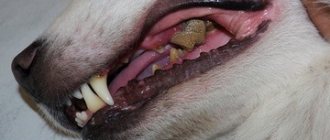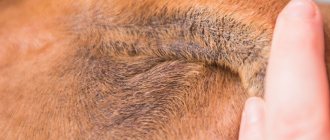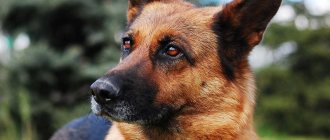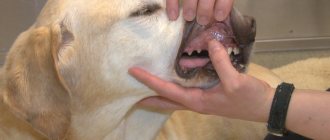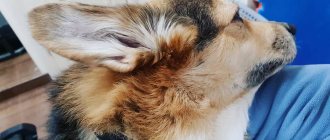The main task of the lymph nodes is to prevent pathogenic microorganisms from entering the dog’s body. While performing this function, they also participate in the redistribution of fluid and produce cells of the immune system. That is why their inflammation requires effective and immediate treatment. Why do lymph nodes become inflamed? What are the symptoms of the disease in a dog? What is the treatment? For more details, see below.
Read in this article:
What is this?
Causes of inflammation of the lymph nodes
Symptoms of the disease: when should you contact a veterinarian?
Diagnostics: basic methods
How is lymphadenitis treated?
What to do at home?
Can complications arise?
Prevention
What is this?
Lymphadenitis (lymphadenopathy) is an inflammatory process affecting the lymph nodes. They perform a filtering function for lymph coming from various internal organs of the pet, and are located next to the blood vessels. That is why their inflammation poses a serious threat to the health and life of the animal.
Forms of lymphadenitis that can be diagnosed in a dog:
- Spicy. All signs of inflammation develop rapidly, and the symptoms are clearly expressed. In 9 out of 10 cases with acute lymphadenitis, the animal experiences a febrile state (increased body temperature).
- Chronic. Its main feature is the “erasure” of symptoms. They do not have the severity characteristic of lymphadenitis and arise gradually. Most often accompanied by pronounced pallor, loss of appetite, and difficulty breathing.
All dog breeds are equally prone to lymphadenitis. However, elderly pets and animals with weakened immune systems are at particular risk. Their health needs to be treated even more carefully in order to prevent dangerous consequences for the entire body.
Causes of inflammation of the lymph nodes
Nonspecific inflammation of the lymph nodes develops when various pathogenic microorganisms enter the lymphatic system of the dog's body (for example, bacteria, rickettsia or viruses). In addition, the causes of the disease can be staphylococci, streptococci and E. coli. In this case, the primary source of infection can be ulcers, inflammatory processes of soft tissues, purulent wounds, as well as caries or thrombophlebitis.
In addition to nonspecific lymphadenitis, there is also specific lymphadenitis, which occurs as a complication of a serious illness in an animal (for example, tuberculosis, brucellosis, salmonellosis).
In approximately 5-7% of all visits to a veterinary clinic in Moscow, the development of lymphadenitis in a pet is provoked by other non-inflammatory factors:
- allergies due to frequent contact with an allergen,
- intoxication of the body,
- significant mechanical damage (for example, from a collar that is too tight),
- autoimmune reactions of the dog's body,
- parasitic disease
- reaction after vaccination of an animal, etc.
The lymph nodes
The parotid lymph node (limphanodus parotideus) is a pair, lies behind the temporomandibular joint and is laterally half covered by the parotid salivary gland, palpable. Dimensions: 10-25 x 5-15 x 4-10 mm. Collects lymph from the skin above the skull to the zygomatic arch and dorsum of the nose, temporomandibular joint, bones of the cranial vault and muscles of the head (zygomatic, temporal, masseter), parotid gland, outer part of the nose, auricle and its muscles, eyes. The outflow occurs through 2-3 efferent vessels to the medial retropharyngeal lymph node and, if present, to the lateral retropharyngeal lymph node.
Mandibular lymph nodes (lnn. namdibulares) - a group of lymph nodes ranging from 2 to (less often) 5, palpable, lying caudolateral to the angular process of the mandible, directly under the skin and cutaneous muscle. Dimensions: 10-55 x 7-30 x 5-10 mm. They are divided into dorsal and ventral groups by the external maxillary vein. Lymph passes through them from the skin of the tip and dorsum of the nose, lips, facial and masticatory muscles, bones of the facial skull, temporomandibular joint, eyelids, rostral part of the nasal mucosa, oral cavity, laryngeal and pharyngeal region of the neck, salivary glands and adjacent areas ventral muscles of the neck. From these, the lymph is directed to the retropharyngeal medial and, if present, lateral lymph nodes.
Facial lymph node (buccal lymph node [1]) (ln. facialis or ln. buccalis) - unstable, may be present only on one side, oval in shape, up to 1.5 cm long, lies along the cranial edge of the superficial facial vein and the mouth of the vein upper lip, laterally covered by skin and cutaneous muscle. The node collects lymph from the skin, facial muscles, mucous membrane and skin of the upper lip, dorsum of the nose, and mucous membrane of the vestibule of the nose. The outflow of lymph from it is carried out in the parotid and (or) mandibular lymph nodes.
lateralis is small (5-7 mm), unstable, present in about a third of cases, but then palpable. Lies at the wing of the atlas above the jugular process, partially covered by the caudal edge of the parotid salivary gland. Almost all the lymph flows through it, flowing from the organs of the head, auricle, muscles above the 1st and 2nd cervical vertebrae, subcutaneous muscle of the neck, as well as from the larynx, pharynx and thyroid gland. From the node, lymph flows through 1-2 efferent vessels into the retropharyngeal medial lymph node.
medialis is permanent, 1.5-6.0 cm long, and lies on the dorsal wall of the pharynx next to the cranial deep cervical nodes. Lymph flows through it, flowing from all organs of the head, and is subsequently sent to the tracheal lymphatic duct and to the cranial deep cervical nodes.
Symptoms of the disease: when should you contact a veterinarian?
An attentive and caring owner will be able to quickly detect a disease in their pet (for example, during play). The main sign indicating the development of lymphadenitis is inflammation of the lymph nodes and their pronounced increase in size. At the same time, they become painful, so the dog may react negatively to even light stroking in the area of inflammation.
Please note that lymph nodes are located throughout the animal’s body: behind the ears, behind the jaw, in the groin, at the base of the neck, and also in the armpits of the forelimbs.
Other signs that will help you identify lymphadenitis in your pet:
- Temperature increase.
The dog’s body temperature rises sharply, in especially severe cases it rises to 42 °C. In this case, general weakness, apathy, and chills occur. The animal refuses food and practically does not drink water. Possible sleep disturbances and severe anxiety.
- Rapid breathing.
It becomes more difficult for your pet to breathe. He experiences severe shortness of breath even in the absence of slight physical activity (running, walking, etc.). At the same time, an increase in heart rate (tachycardia) is observed.
- Visual visibility of lymph nodes.
The lymph nodes located behind the dog's jaw and neck are very noticeable. They increase in size and are easily palpable. Pay special attention to this if you have a short-haired dog - the lymph nodes will be very noticeable.
Have you noticed one or more signs of lymphadenitis in your pet? Don’t hesitate - urgently contact a professional veterinarian in Moscow. Self-treatment is unacceptable! Do not risk the health and life of your dog - take it to a veterinary clinic, where your pet will receive qualified care.
Symptoms of the disease
An attentive and caring owner can detect pathology by petting and playing with the animal. Veterinary specialists include the following characteristic clinical signs of the disease:
- A sharp increase in temperature to 42C. Fever in an animal is accompanied by weakness, apathy, and chills. The dog flatly refuses food.
- In some cases, the owner observes sleep disturbances.
- Some individuals experience tachycardia and rapid breathing.
- Normally, only the lymph nodes located in the groin can be felt in a dog. With the development of an inflammatory reaction in the organ, regional nodes increase in size and become painful. The animal reacts negatively even to light stroking in the area of pathology.
- Submandibular and cervical nodes become visible to the naked eye, especially in short-haired breeds.
- A complication of inflammation by purulent microflora is accompanied by redness of the skin in the area of the lymph node.
Having discovered signs of lymphodenitis, the owner should seek qualified help as quickly as possible, since self-medication due to the complexity of the disease is unacceptable.
Diagnostics: basic methods
Inflammation of the lymph nodes is a very dangerous disease. Taking into account the characteristics of lymph and its movement, the likelihood of infection spreading throughout the pet’s body increases. If you do not respond to the problem in a timely manner and do not seek professional help, then all the internal organs and systems of the pet will be affected by infection.
The main methods used to diagnose lymphadenitis:
- thorough visual inspection of the pet,
- careful palpation of the lymph nodes (in the groin area, under the jaw, etc.),
- laboratory blood test to determine the level of leukocytes and eosinophils,
- taking a puncture from a lymph node to determine the nature of the inflammation.
X-ray and ultrasound methods are widely used in diagnosing the disease. In this case, a biopsy is performed (excision of a piece of tissue for microscopic examination), which allows us to determine the main cause that provoked inflammation in your pet’s body.
How is lymphadenitis treated?
The key to successful treatment of lymphadenitis in a dog is contacting a reliable veterinary clinic. Here they will not only quickly and accurately make a diagnosis, but also prescribe effective therapy. In the treatment of lymphadenitis, an integrated approach is important, so the veterinarian prescribes pharmacological drugs of various spectrums of action.
Firstly, the inflammatory process is suppressed. For these purposes, a course of antibiotics is prescribed, selected by the doctor taking into account the sensitivity of the pathogenic microorganisms that provoked the development of the disease in the dog.
Secondly, hepatoprotectors (drugs intended to maintain liver function) and probiotics are prescribed. They prevent the occurrence of side effects from antibiotics, since their use must be long-term and regular.
Thirdly, a vitamin-mineral complex is prescribed. Typically, special emphasis should be placed on vitamin A (retinol), vitamin B2 (riboflavin) and vitamin C (ascorbic acid). They will help the dog’s body recover much faster from illness.
In cases where inflammation of the lymph nodes is accompanied by a purulent process, surgical treatment is prescribed. It is necessary to open the inflamed area of tissue, and then install drainage (to remove exudate). Subsequently, the rehabilitation period includes regular application of anti-inflammatory ointments and the use of drugs to strengthen the animal’s immune system.
In some cases, your pet may be prescribed physiotherapeutic procedures. For example, heat treatment (ultra-high frequency therapy) helps to quickly reduce the inflammatory response. However, it is important to consider contraindications, the main of which is the detection of malignant neoplasms (oncology).
Treatment of lymphadenitis
Treatment of the disease is complex. First of all, the veterinary specialist directs efforts to suppress the causative agent of the inflammatory process. For this purpose, the sick animal is prescribed a course of antibiotics. The best effect is achieved if antibacterial drugs are selected taking into account the sensitivity of pathogenic microorganisms that cause inflammation.
As a rule, sulfonamide drugs and cephalosporin antibiotics are used to treat lymphadenitis. A feature of the treatment of the disease is the long-term use of antibacterial agents. In this regard, the veterinary specialist recommends that owners give the dog hepatoprotectors and probiotics to avoid complications.
When a purulent process develops, the veterinarian often resorts to a surgical method to treat lymphadenitis. After opening the inflamed area, drainage is installed to remove exudate. Anti-inflammatory ointments, including Vishnevsky's liniment, are applied to the diseased area.
According to indications, a veterinary specialist often prescribes physical procedures for the animal. Heat treatment (UHF therapy), depending on the stage of the disease, helps reduce the inflammatory response in the pathological focus. But it is contraindicated in case of cancer.
Strengthening the body's immune system plays an important role in the treatment of the disease. For this purpose, the dog is prescribed immunostimulants - Interferon, Immunofan, Nucleopeptide, Maxidin, etc. The animal’s diet is adjusted, enriching it with vitamins and minerals. Vitamin A, riboflavin, and ascorbic acid are important for increasing resistance.
What to do at home?
The first thing to do when you notice signs of lymphadenitis is to contact a veterinarian as soon as possible. This will make it possible to diagnose the disease in a timely manner and prescribe an effective course of therapy or surgical intervention (for example, if the inflammation is accompanied by purulent processes).
The next step is to provide a comfortable environment for the dog. Upon returning from the clinic, do not neglect the doctor's instructions. Give the animal the prescribed medications at a strictly defined time. Make sure that the pet is in a warm and clean place where there are no drafts. Take care of his nutrition, include more vitamins and minerals so that your dog’s strength will be restored even faster.
Can complications arise?
If you promptly seek help from a veterinarian and treat your dog in accordance with his instructions, you will be able to avoid complications that arise from inflammation of the lymph nodes in animals. If this is not done, the functioning of the entire lymphatic system will be impaired, which means that the pet will lose the natural barrier that protects it from infections.
With nonspecific lymphadenitis, the following complications are possible:
- phlegmon,
- abscess,
- thrombophlebitis,
- sepsis,
- lymphostasis, etc.
The prognosis in the absence of treatment is death.
Inflammation of the lymph nodes (lymphadenitis) in dogs
Content
- Causes
- Diagnostics
- Treatment
- Forecast
Inflammation of the lymph nodes in dogs is lymphadenitis.
In dogs, like in other animals, it occurs independently or secondary to other diseases. The course of lymphadenitis can be acute or chronic. The localization of the process can be local or regional and systemic or multicentric, depending on the affected area. The superficial lymph nodes located under the skin and the internal lymph nodes located inside the cavities of the body can become inflamed separately. Also, internal and superficial lymph nodes can become inflamed together.
Causes
Based on the distribution of inflammation, one can determine the affected area and suggest the systemic nature of the disease.
Inflammation of the lymph nodes can be specific, i.e. against the background of another disease (mostly systemic) and nonspecific, caused by damage to the lymph node itself or the area, organ, tissue near it. An example of specific lymphadenitis: brucellosis, lymphoma. Example of nonspecific: hematoma, caries.
There are also non-inflammatory causes of lymphadenitis:
- Allergic reactions (if the dog comes into contact with allergens too often).
- Autoimmune reactions
- Infection of an animal with parasites (for example, sarcoptic mange)
- Post-vaccination reaction
Lymphadenitis will be manifested by an enlarged lymph node, pain, and increased temperature in the affected area. With systemic lymphadenitis, there will also be increased body temperature, lethargy, and refusal to eat.
Local lymphadenitis can become systemic if timely treatment is not provided.
Acute lymphadenitis sometimes develops into a chronic form; the chronic form is characterized by enlargement and hardening of the lymph nodes, while at the same time there is practically no painful sensation. The chronic form of inflammation of the lymph nodes can occur due to various microtraumas, chronic inflammation or frequent inflammation of various organs and tissues.
Diagnostics
Lymphadenitis can be diagnosed at an appointment with a veterinarian by examination and palpation of the superficial lymph nodes. Inflammation of the internal lymph nodes can be detected by ultrasound. To identify the root cause of lymphadenitis, the following studies will be needed:
- Clinical and biochemical blood tests.
- General urine analysis.
- Biopsy or aspiration cytology from the lymph node.
- X-ray examination.
- Ultrasound examination of the abdominal cavity.
- Cytological blood test
- Bone marrow biopsy
In severe cases, to clarify the prognosis and extent of damage, a standard examination is supplemented by computed tomography and magnetic resonance imaging.
Treatment
Treatment of lymphadenitis depends on the cause that led to it. If the cause of the disease is a bacterial infection, then treatment requires antibiotic therapy. If there were fungal pathogens, then antifungal agents were used. In case of allergies, the condition is stabilized with antihistamines or hormonal drugs. In cases of accumulation of pus in the lymph node, it is necessary to surgically open the abscess and install drainage. If the lymph nodes of the groin area are inflamed, castration of the animal may be necessary. If the cause of lymphadenitis in a dog is leukemia, then the main treatment method will be chemotherapy or radiation therapy.
Forecast
Prognosis will depend on the underlying cause of inflammation, proper treatment and response to it. If treatment of the disease was started promptly and correctly, and was carried out strictly under the supervision of a veterinarian, then the prognosis of the disease will be favorable. If proper treatment is not given, scarring of the lymph node may occur and the infection may spread to other organs. With systemic inflammation without proper treatment, the prognosis will be poor.
Thus, with proper maintenance, care, hygiene and treatment, inflammatory reactions from the immune system and lymph nodes in particular can be minimized.
The article was prepared by Nikulina E.A.,
veterinary endocrinologist at MEDVET © 2021 SEC MEDVET
Prevention
It is best to take care of your dog’s condition in advance and take preventative measures that will help avoid inflammation of the lymph nodes. The most important thing is to treat infectious diseases in a timely manner, since in most cases they provoke the development of lymphadenitis in the animal. Do not self-medicate, seek help from experienced and qualified veterinarians.
Other preventive measures that will help avoid inflammation of the dog’s lymph nodes:
- Never neglect allergic manifestations . It is best to quickly detect the allergen and eliminate it from your pet’s life;
- Take steps to strengthen your dog's immune system. The stronger it is, the more reliably it resists any viruses, parasites and fungi;
- Stick to a balanced diet. Choose food that is suitable for your dog's breed and age.
Remember that your pet needs your attention and care. Unfortunately, he will not be able to say what is bothering him, so it is necessary to be attentive to the health of the animals. Do not neglect regular preventive examinations at the veterinarian and seek qualified help in a timely manner.
Health to you and your pet!




